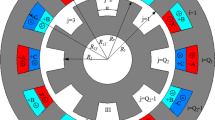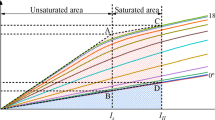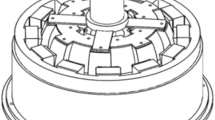Abstract
This paper aims to investigate the torque production mechanism and its improvement design in switched reluctance machines (SRMs) based on field modulation principle. Firstly, the analytical expressions of the air-gap magnetic field are derived from the perspective of DC- and AC-components, respectively. Meanwhile, different slot/pole combinations and winding arrangements are considered. Secondly, the torque productions are analyzed and evaluated with emphasis on the interaction between the DC- and AC-components of air-gap fields. Thirdly, the 12-slot/8-pole and 12-slot/10-pole SRMs are established and studied by using the finite-element method. The effects of slot/pole combination and winding arrangement on the average torque production are clarified. Then, two new designs to improve the average torque are proposed. Finally, the prototype of the 12-slot/10-pole SRM is manufactured, and the experiments are carried out for validation.
Similar content being viewed by others
References
Hadla H, Santos F. Performance comparison of field-oriented control, direct torque control, and model-predictive control for SynRMs. Chin J Electr Eng, 2022, 8: 24–37
Yu Z, Gan C, Ni K, et al. Dual-electric-port bidirectional flux-modulated switched reluctance machine drive with multiple charging functions for electric vehicle applications. IEEE Trans Power Electron, 2021, 36: 5818–5831
Rana A K, Teja A V R. A mathematical torque ripple minimization technique based on a nonlinear modulating factor for switched reluctance motor drives. IEEE Trans Ind Electron, 2022, 69: 1356–1366
Song S, Fang G, Hei R, et al. Torque ripple and efficiency online optimization of switched reluctance machine based on torque per ampere characteristics. IEEE Trans Power Electron, 2020, 35: 9608–9616
Diao K, Sun X, Lei G, et al. Multimode optimization of switched reluctance machines in hybrid electric vehicles. IEEE Trans Energy Convers, 2021, 36: 2217–2226
Mecrow B C, El-Kharashi E A, Finch J W, et al. Preliminary performance evaluation of switched reluctance motors with segmental rotors. IEEE Trans Energy Convers, 2004, 19: 679–686
Sun W, Li Q, Sun L, et al. Development and investigation of novel axial-field dual-rotor segmented switched reluctance machine. IEEE Trans Transp Electrific, 2021, 7: 754–765
Ding W, Hu Y, Wang T, et al. Comprehensive research of modular e-core stator hybrid-flux switched reluctance motors with segmented and nonsegmented rotors. IEEE Trans Energy Convers, 2017, 32: 382–393
Davarpanah G, Faiz J. A novel structure of switched reluctance machine with higher mean torque and lower torque ripple. IEEE Trans Energy Convers, 2020, 35: 1859–1867
Xu Z, Liu J, Kim M J, et al. Characteristics analysis and comparison of conventional and segmental rotor type 12/8 switched reluctance motors. IEEE Trans Ind Applicat, 2019, 55: 3129–3137
Yan W, Chen H, Liao S, et al. Design of a low-ripple double-modular-stator switched reluctance machine for electric vehicle applications. IEEE Trans Transp Electrific, 2021, 7: 1349–1358
Ma J, Li J, Fang H, et al. Optimal design of an axial-flux switched reluctance motor with grain-oriented electrical steel. IEEE Trans Ind Applicat, 2017, 53: 5327–5337
Ding W, Yang S, Hu Y. Development and investigation on segmented-stator hybrid-excitation switched reluctance machines with different rotor pole numbers. IEEE Trans Ind Electron, 2018, 65: 3784–3794
Hua W, Hua H, Dai N, et al. Comparative study of switched reluctance machines with half-and full-teeth-wound windings. IEEE Trans Ind Electron, 2016, 63: 1414–1424
Husain T, Uddin W, Sozer Y. Performance comparison of short-pitched and fully pitched switched reluctance machines over wide speed operations. IEEE Trans Ind Applicat, 2018, 54: 4278–4287
Deng X, Mecrow B, Wu H, et al. Design and development of low torque ripple variable-speed drive system with six-phase switched reluctance motors. IEEE Trans Energy Convers, 2018, 33: 420–429
Gan C, Sun Q, Jin N, et al. Cost-effective current measurement technique for four-phase SRM control by split dual bus line without pulse injection and voltage penalty. IEEE Trans Ind Electron, 2018, 65: 4553–4564
Hu Y, Wang T, Ding W. Performance evaluation on a novel power converter with minimum number of switches for a six-phase switched reluctance motor. IEEE Trans Ind Electron, 2019, 66: 1693–1702
Deng X, Mecrow B, Martin R, et al. Effects of winding connection on performance of a six-phase switched reluctance machine. IEEE Trans Energy Convers, 2018, 33: 166–178
Yan F, Ji J, Ling Z, et al. Magnets shifting design of dual PM excited vernier machine for high-torque application. Chin J Electr Eng, 2022, 8: 90–101
Zhu S D, Zhao W X, Ji J H, et al. Design to reduce electromagnetic vibration in integral-slot SPM machine considering force modulation effect. Sci China Tech Sci, 2022, 65: 1867–1877
Zhu X, Cheng M, Wang Y, et al. Mathematical analysis model of double-stator field modulation HTS machine based on general airgap field modulation theory. IEEE Trans Energy Convers, 2022, 37: 475–486
Hua H, Hua W, Zhao G, et al. Torque production mechanism of switched reluctance machines with air-gap field modulation principle. IEEE Trans Energy Convers, 2020, 35: 1617–1627
Zhu X, Zhao W, Xu L. Distribution design of modulator for split-pole flux-modulation permanent-magnet machine. IEEE Trans Energy Convers, 2021, 36: 1614–1624
Deng X, Mecrow B, Wu H, et al. Cost-effective and high-efficiency variable-speed switched reluctance drives with ring-connected winding configuration. IEEE Trans Energy Convers, 2019, 34: 120–129
Author information
Authors and Affiliations
Corresponding author
Additional information
This work was supported by the National Natural Science Foundation of China (Grant No. 52025073), and the Postgraduate Research & Practice Innovation Program of Jiangsu Province (Grant No. KYCX21_3358).
Rights and permissions
About this article
Cite this article
Sun, Y., Zhao, W., Ji, J. et al. Torque production mechanism of switched reluctance machines with field modulation principle. Sci. China Technol. Sci. 66, 2743–2754 (2023). https://doi.org/10.1007/s11431-022-2246-7
Received:
Accepted:
Published:
Issue Date:
DOI: https://doi.org/10.1007/s11431-022-2246-7




